
Tippett studio’s shots in ‘Twilight Saga: Breaking Dawn Part 1’ were at the heart of two of major sequences featuring members of the film’s werewolf tribe, all of whom were digitally designed, built and animated at Tippett. Tippett has been creating the wolf characters for the Twilight Saga series since the second film ‘New Moon’ in 2009, followed by ‘Eclipse’ in 2010.
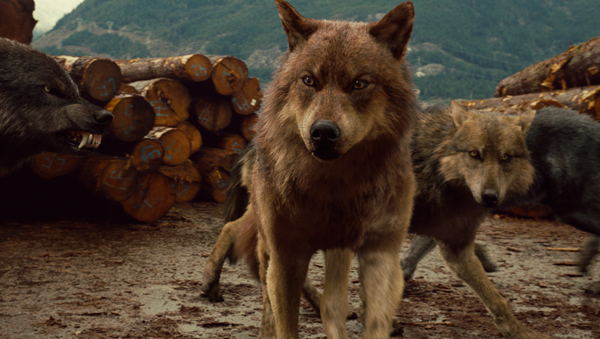 |
|
| Each time the team has aimed to improve the looks, animation and plate integration of the wolves until now in ‘Breaking Dawn Part 1’, their third movie, their work on lighting, fur and emotional performances from the wolves has produced impressive results.
A different director has directed each of the films in the Twilight Saga. Tippett’s Visual Effects Supervisor Eric Leven described the relationship director Bill Condon developed with the team. “On the previous films, we had directors who were concerned with making the wolves come across emotionally for the audience, or being sure that the wolves were as photorealistic as possible. Having already seen what we were able to do, Bill Condon wasn’t worried about those issues. |
|
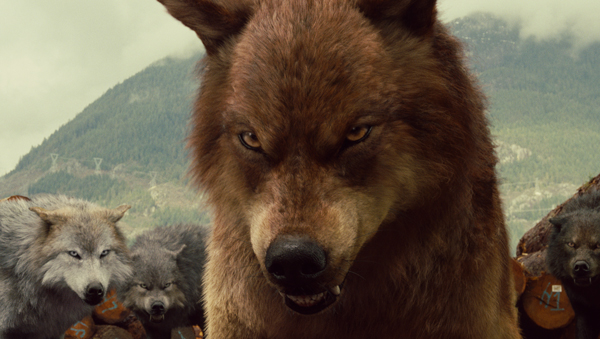 |
|
| Wolf-centric Sequences “His primary concern was to avoid having a distinct, animated movie stuck into the middle of his own film, and he was especially concerned about the sequence in which the characters get together and talk in wolf form. If the tone wasn't right, the scene could have played out looking very silly. Therefore, this became the first task Senior Visual Effects Supervisor Phil Tippett really wanted to tackle.” Bill, Phil and the team worked together with an unusual level of collaboration. Because two of the scenes were so wolf-centric, once the script had been finalised for their scenes, the team prepared animatics for each of them and had them approved before going on set. They concentrated on shooting what Bill had signed off on and ensuring the footage would cut together as expected when it was delivered to editorial, both for production and for their animators. This proved especially challenging for the fight sequence between several wolves and human characters, which was split up between two different units over six days of shooting. They also watched the actors' performances very closely, making sure that these would work with the wolves that will be added in later. “Some shots had six actors valiantly fighting invisible wolves, sometimes using giant wolf-shaped bean bags, and sometimes using just pantomime,” said Eric. “Between takes, we'd mention to the actors, ‘Your punches are landing too high’, or ‘Sam is bearing down on you faster than that’. And of course, the goal for the entire film unit was getting all the shots we need in the few days allotted to the shoot for the scene. Without the animatics, this would have been impossible.” |
|
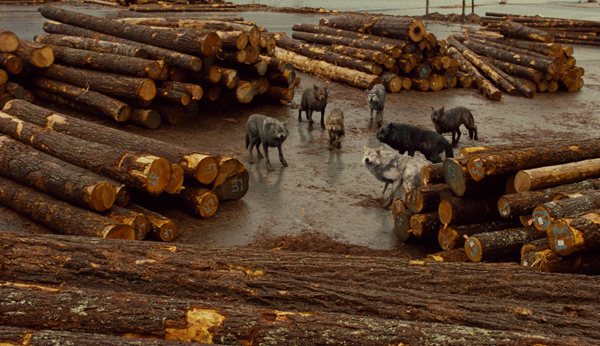 |
|
| Pre-production to Post While Tippett had created fairly detailed animatics for ‘New Moon’ when two lead wolves were fighting, this was the most involvement they had ever established in preproduction for a Twilight movie, designing the sequence from script to screen and producing storyboards, animatics and a scratch track. Eric feels the close focus of their scenes on the wolves necessitated this effort. Eric said, “I think the advantage has been that, as the group responsible for the actual work, we are sensitive to what it takes to get that work done - not just in post, but during production as well. For example, the lumberyard scene needed to be shot in only one and a half shooting days. So our camera position and lens selection took that into account. How long will it take to set up this shot on the day? How about relighting for this next shot, and so on.” The pressure was on from several directions. “In addition to making sure the scene played dramatically, that the characters performed correctly as wolves, and that the audience understood instantly that they are not talking but communicating telepathically, and that the whole scene didn't seem like a small, distracting animated movie-within-a-movie - we also needed to make sure we could work with second unit to actually shoot the scene shot in a very short time,” said Eric. |
|
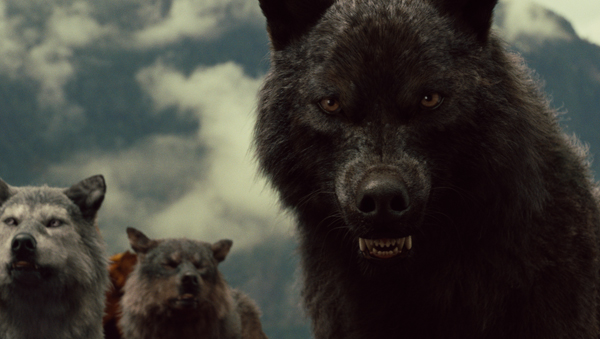 |
|
| On-set Reference Anticipating the work to be done back at the studio, Eric and the on set crew also captured a complete, standard set of VFX reference for each camera setup - HDRI environment photos, location survey for matchmove, grey sphere reference for lighting and color balance – plus reference photos of plants. “Sometimes we'll shoot reference plates with lots of plants and trees, as well as a clean hero plate without, to make it easier to composite wolves into the dense forest and add foliage in post,” he said. “But the most helpful reference for everyone for this project was the wolf standees - full size wolf-shaped cardboard cutouts that make it clear to everyone, from the camera operator to the animator, exactly where and how large the wolf is supposed to be in the shot. We may change that later, but it makes the work much smoother if everyone has a common starting point.” |
|
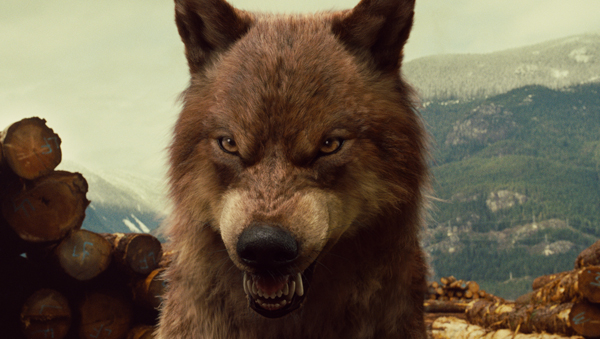 |
|
| Ready to Edit After having spent about two months on the lumberyard animatic and another month or so on the fight scene, about 150 shots in all, the animatics played as completed scenes, so in that way they already had a rough cut. When the footage came back and editor Ginny Katz was assembling it, Bill allowed them to work with editorial to make further decisions together when necessary. Although some dialogue and specific shots changed between the animatic and the finished movie, the overall feel of the scene was maintained. The post camera moves were often crucial to making sure the shots worked with the animation, and have been since Tippett’s initial work with the wolves on ‘New Moon’. “Because these wolves are often times the only characters in the shots, we're frequently shooting empty plates,” said Eric. “Even though we've previs’d and planned the shots ahead of time, when a pair of six foot wolves are in a dogfight, for example, you can't always anticipate exactly how fast or exactly where to pan the camera to follow them. So we shoot on VistaVision cameras whenever possible, which can give us a nice big negative where we can get exactly the right framing after the shoot.” Shooting Style At first they tried a cinematic approach to the camera work, using deliberate camera framing to indicate who was talking, since the voice tracks would be over dubs with no lip movement. Furthermore, the voices were going to be mixed to create confusion and chaos, as the sequence was supposed to feel inside the character Jacob's head. “When the cinema style proved to be a little too obvious,” said Tom, “we approached it more like documentary, using a moving camera to capture long shots allowing more audience immersion into the wolf pack and needing fewer edits reminding them they are watching a film. In the end we mixed both styles.” Think Like a Wolf “For instance, when younger ‘omega status’ wolves approach alpha members, they carry their tails curled under between their legs, approach low and come up under the Alpha's neck with a lot of muzzle darting and licking. Played out on screen to an unfamiliar audience, this looks very weak and submissive, almost like kissing. Contrasted with the character of the wolf pack when in human form, this behaviour would also confuse the audience. So we find other ways to show power and status and rank in the pack.” Also, when fighting, they have learned that a wolf uses its teeth and legs in a particular way to gain advantage and dominate its opponent. They were allowed to take advantage of their knowledge of this and other very specific traits without interference or contradiction, not only for this film but for the next in the series – with very effective results. Light and Fur Tippett Studio runs a modelling and animation pipeline based mostly on Autodesk Maya. For this project, Howard explained that they really wanted to improve on the wolves and be able to reveal every wrinkle and muscle twitch. “We made big advancements in our fur and light shaders to get us a more naturalistic illumination and sheen in our fur. Our lights now simulate very closely how light is transmitted through millions of individual hairs. As a result we can achieve a high level of believability much faster.” Area Lights When shooting outside, Howard has found that it is virtually impossible to maintain exact same lighting conditions hour to hour let alone day to day. “Luckily, we had our team on set during the shoot gathering HDRI data and reference for each shot. The first thing a lighter does is study the reference for his or her shot and compare their plate to shots that come before and after,” he said. “In cases where the plate was dramatically altered, such as a day-for-night shot, we would try to colour correct our reference to match the new plate. So the overall lighting approach is the essentially the same, it just may require more revisions as the background evolves.” Controlled Composite “But we did continue to ask the TDs to remove most of the brow ridge shadows that would fall onto the eyes from their renders. Consequently all of wolves’ eyes would come out a bit flat and too bright from the lighting department, but it allowed the artists in the comp to have full control on sinking the eyes back into the head with the appropriate amount of drop shadow, grading and ideal placement of the highlights. I think our wolves eyes on Breaking Dawn have been the most successful to date.” Integrated Wolves “One of our compositors on the team, Adam Hazard, set up a sly build to integrate the reflections across the shots in the sequence using Nuke. Otherwise, it was up to us to finish things off with the subtle nuances of, for example, matching the blacks, whites, focus and atmospheric haze from the over exposed skies. We even went in and built in a red fringing artefact found in the plates to apply to our wolves when they were up against the bright sky to match what was going on in those lumber yard plates.” A number of photographic elements were shot for the lumber yard sequence. Conveniently, a shop that sculpts furniture from redwood trees with chainsaws is located near the studio, where they could pick up buckets of redwood mulch, chips and sawdust to shoot as elements on their stage. “These elements matched up with the redwood mulch and bits found in the plates pretty successfully and played nicely in our comps. It's integrating these types of elements that help tie our wolves into the environment and help sell the believability of it all.” |
|


















